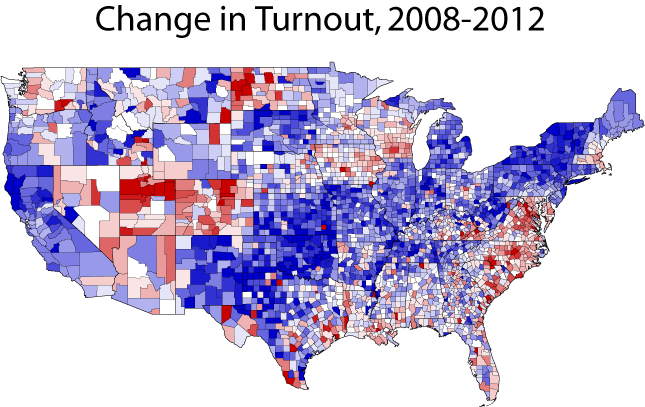See other Resistance Articles
Title: The Case of the Missing White Voters, Revisited
Source:
[None]
URL Source: http://www.realclearpolitics.com/ar ... e_voters_revisited_118893.html
Published: Jun 21, 2013
Author: Sean Trende
Post Date: 2013-06-21 19:54:14 by Jethro Tull
Keywords: None
Views: 49
Comments: 1
With a cloture vote on the Senate’s immigration reform bill expected next week, countless commentators have expressed the view that if Republicans don’t sign on for reform, the party is doomed at the presidential level for a generation. This is the first in a two-part series explaining why this conventional wisdom is incorrect. Signing on to a comprehensive immigration package is probably part of one way for Republicans to form a winning coalition at the presidential level, but it isn’t the only way (for more, I’ve written a book about this, as well as countless articles here at RCP). Today I’ll re-examine what was really the most salient demographic change in 2012: The drop-off in white voters. Next time, we’ll confront some of the assumptions embedded in the “GOP has to do this” argument head-on. I should re-emphasize at the outset that I think that embracing some sort of immigration reform probably helps with Republicans’ outreach efforts to Hispanics, and the idea that there is a treasure-trove of votes to be had for Democrats here is almost certainly overstated. I should also re-emphasize that from a “pure policy” standpoint, I find quite a bit to like in the basic “Gang of Eight” framework. But regardless of whether Republicans could or should back the bill, it simply isn’t necessary for them to do so and remain a viable political force. 1. The most salient demographic change from 2008 to 2012 was the drop in white voters. Let’s start with the basics: Just what were the demographic changes in that four-year span? I did some preliminary work in November 2012 suggesting that the largest change came from white voters dropping out. Now, with more complete data, we can re-assess this in a more precise manner. Using the most commonly accepted exit-poll numbers about the 2008 electorate*, we can roughly calculate the number of voters of each racial group who cast ballots that year. Using census estimates, we can also conclude that all of these categories should have increased naturally from 2008 to 2012, due to population growth. From mid-2008 to mid-2012, the census estimates that the number of whites of voting age increased by 3 million. If we assume that these “new” voters would vote at a 55 percent rate, we calculate that the total number of white votes cast should have increased by about 1.6 million between 2008 and 2012. The following table summarizes these estimates for all racial groups, and compares the results to actual turnout. Now, the raw exit-poll data haven’t come out yet, so we can’t calculate the 2012 data to tenths: The white vote for 2012 could have been anywhere between 71.5 percent of the vote or 72.4 percent (with 26,000 respondents, analysis to tenths is very meaningful). So the final answer is that there were 6.1 million fewer white voters in 2012 than we’d have expected, give or take a million.** The Current Population Survey data roughly confirm this. As I noted earlier, if you correct the CPS data to account for over-response bias, it shows there were likely 5 million fewer whites in 2012 than in 2008. When you account for expected growth, we’d find 6.5 million fewer whites than a population projection would anticipate. This is the real ballgame regarding demographic change in 2012. If these white voters had decided to vote, the racial breakdown of the electorate would have been 73.6 percent white, 12.5 percent black, 9.5 percent Hispanic and 2.4 percent Asian -- almost identical to the 2008 numbers. 2. These voters were largely downscale, Northern, rural whites. In other words, H. Ross Perot voters. Those totals are a bit more precise and certain (and lower) than my estimates from November of last year. With more complete data, we can now get a better handle regarding just who these missing white voters were. Below is a map of change in turnout by county, from 2008 to 2012. Each shade of blue means that turnout was progressively lower in a county, although I stopped coding at -10 percent. Similarly, every shade of red means that turnout was progressively higher, to a maximum of +10 percent. The drop in turnout occurs in a rough diagonal, stretching from northern Maine, across upstate New York (perhaps surprisingly, turnout in post-Sandy New York City dropped off relatively little), and down into New Mexico. Michigan and the non-swing state, non-Mormon Mountain West also stand out. Note also that turnout is surprisingly stable in the Deep South; Romney’s problem was not with the Republican base or evangelicals (who constituted a larger share of the electorate than they did in 2004). Poster Comment: It appears 6.1 million less Whites voted in '12 than in previous years. Who are these stay-at-home voters? We're the old America First, Ross Perot voting block, the very group of people who the Rs continue to alienate with their big business, open border policies. Very interesting....The Case of the Missing White Voters, Revisited
The Case of the Missing White Voters, Revisited



Post Comment Private Reply Ignore Thread
Top • Page Up • Full Thread • Page Down • Bottom/Latest
#1. To: Jethro Tull (#0)
Look out below.
"Mr. Prime Minister, there is only one important question facing us, and that is the question whether the white race will survive." -- Leonid Brezhnev to James Callahan
Top • Page Up • Full Thread • Page Down • Bottom/Latest
